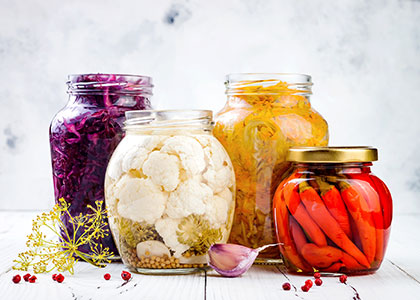
Why Enjoy Fermented Foods
By Team Reboot
Fermented foods are having a moment. These days, kombucha is often offered on menus alongside the wine list. And other fermented foods — such as yogurt and kimchi — have a long history of being available.
What Are Fermented Foods?
To put it simply, fermented foods use microorganisms like yeast and bacteria that transforms the products found in foods, according to the National Heart Foundation of New Zealand.
Historically, this was a preservation method that helped foods last longer in times when refrigeration wasn’t readily available. That is, a cabbage will go back quickly but sauerkraut remains edible longer.
Plus, fermented foods often taste delicious — think sourdough bread or beer, for instance.
These days, people often seek out fermented foods because they contain probiotics, aka gut-friendly bacteria.
The Benefits of Fermented Foods
Take a look at some of the biggest benefits of fermented foods, via the Cleveland Clinic:
They contain gut-friendly bacteria known as probiotics that help you digest food
They ward off less friendly bacteria
They help your body produce certain vitamins
They can add to the diversity of bacteria found in your gut — which is good for your overall health
They can restore the bacteria balance in your gut after antibiotics knock it off course
Here’s more on why you should eat fermented foods.
Try These Options
There are plenty of fermented foods to try if you’re interested in adding them to meals. Take a look at some popular and readily available options:
Kimchi — a spicy Korean side dish made with cabbage and other veggies
Yogurt — a dairy product made by fermenting milk. While it’s great on its own, you can also add it to cereals, use it to top spicy dishes or include it in smoothies or baked dishes.
Kefir — this yogurt-based drink is full of probiotics and other nutrients. You can drink it straight, add it to cereal and other recipes or include it in your next smoothie.
Kombucha — This fizzy beverage is made with tea.
Miso — Maybe you’re most familiar with miso through miso soup. Miso is made from fermented soy beans.
Sauerkraut — as with kimchi, it’s made with cabbage, but has a sour, not spicy, flavor